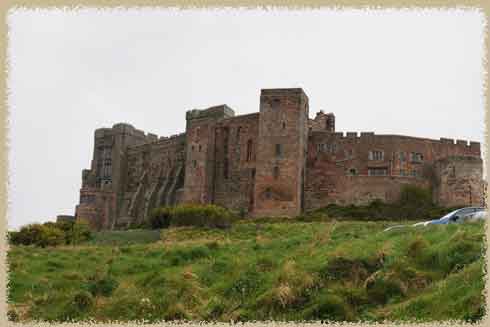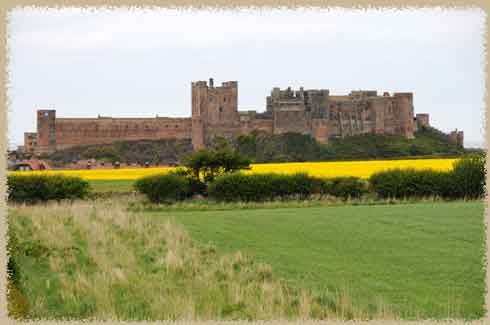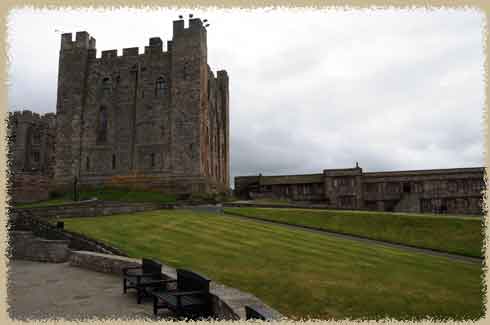Bamburgh Castle
We reallly need to spend more time in England -- the castles here are AMAZING. When we ran into the couple from Northumberland while taking pictures of Greenowe Tower, they were absolutely insistent that we visit Bamburgh and Alnwick castles. I am totally going to plan a castle-touring trip in England. Of course, we'll have to go for six months or more...

the outer walls of the enormous castle
A long history
The outcropping of basalt here has been the site of a fortiification since the iron age. In the 8th century BCE, the Votadini drive built a fortification here. It was a fort for a the native Briton tribe in the first century BCE. Roman occupied the site as they marche dnorth into Scotland between 43-410 CE.
A castle was referenced here in 547 CE, as the kings of Northumbria settled here and the castle here became the royal capital. It is likely that the site is named after the wife of an early Briton ruler, named Bebba -- hence, Bebanburgh.

a view from the main road of the whole castle
The current castle traces its roots to the Norman forticiation built here in the 10th century. It survived seige by William II in 1095 but was eventually surrendered to the king. It passed to Henry II. During the War of the Roses it was the first castle in England to be taken by artillery -- although it took 9 months.
The castle remained in crown hands, managed by a member of the Forster family for nearly 400 years, until it was eventually given to one of the family (John Forster) for his service in 1610. It remained in the family until c1700, the upkeep of the huge castle is an evern larger strain on the family finances, and when the owner was declared bankrupt his assets were siezed and sold to the Bishop of Durham to settle the debt.
The castle was restored during the 18th and 19th centuries, and passed through many hands, until it was bought by an industrialist in 1894, who restored the castle as it stands today. He installed cental heating (of his own invention) an electricity (hydro-electric) into the castle before his death in 1900. The castle remains the home of the Armstrong family.
The Castle
The site covers 9 acres on a rocky outcrop, with tall curtain walls and towers facing the landward side. The huge square tower was chartered in 1164 (for the princely sum of £4). It is still the centerpiece of the current castle.
In 1221 Henry III added the luxurious Great Hall, separate from the keep, with glass windows and stone chimneys. By the mid-15th century, the castle was enlarged and additional fortifications were added -- and promptly demolished by artillery during the reign of Henry VI.

from the lower ward to the keep
There are 14 rooms open to tourists, and artwork, artefacts, and historical documents related to the castle are on display. There are also private apartments for the Armstrong family still living at the castle, and there are tenants in many of the buildings living in rented flats. Since the castle was at one time used as a school, I imagine the buildings were restored to provide housing --these areas are not open to the public.

